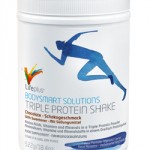Discover easy ways to increase the amount of high-quality protein in anyone’s diet.
Proteins chemically comprise more than twenty amino acids that are linked together by what are called peptide bonds. Although some proteins are enzymes and are used many ways by the body, the body uses the great majority of proteins and the amino acids they are made of to build muscles, other enzymes and hormones. That’s why the amino acids in proteins are often referred to as “building blocks” rather than “fuel.” Eight of the amino acids that make up proteins are classified as essential, meaning the body is not capable of manufacturing them by using other ones.
Protein can be found in a variety of dietary sources, the most abundant of which are various meats, poultry and fish – basically “flesh foods.” This should be no surprise, because we know the amino acids in protein serve as the building blocks of muscle tissue. While all meat contains protein, not every choice is healthy for your diet. So the next time you are standing at the butcher counter, how will you know which source of protein to choose?
As a general rule, the wilder an animal is, the healthier the meat will be, usually because it has been raised on natural grasses and is not loaded with hormones, and it is usually leaner as well. That means choices such as elk, bison, venison and pheasant usually are healthier than is farm-raised beef or chicken. This is largely a result of the fact that wild animals eat a diet that results in a healthy ratio of omega-6 to omega-3. Nutrients never exist alone. When trying to increase one nutritional component in your diet, such as protein, you must also examine the other nutrients you will be ingesting, such as fats.
Our bodies are designed to live on a lipid or fat ratio near 1:1 of omega-6 to omega-3. After large commercial agriculture was developed, that ratio rose to around 4:1. Today, due to our practice of fattening our meats with grain, that ratio can be as high as 50:1. This process is unnatural and changes the nutritional content of the animal’s meat. Wild animals are not subjected to the same unnatural diet. While animals that are raised on a natural diet of grasses have a ratio of about 4:1, animals that have been raised on corn and grain have a ratio close to 20:1. Consequently, the meat from wild animals is a healthier source of protein. No matter what kind of meat you choose, always look for lean cuts and remove any excess fat before cooking.
Fish and shellfish are also good sources of protein and tend to be much lower in fat than are land-based meats. However, they can have the same omega-3 fatty acid imbalance as beef, because the nutritional content of fish is also strongly affected by their diets. Wild tuna, salmon and mackerel will always be healthier sources of protein than their farm-raised counterparts will be. It’s very important to read labels carefully in order to find out where the fish came from. Similar to meat-based sources of protein, many dairy products are also good choices. Low-fat varieties of milk, yogurt, cheese and kefir, for example, all contain ample amounts of protein.
There are also plenty of plant-based options to provide the amino acids acids we need, so we won’t tire of eating the same foods over and over again. However, plant proteins are generally incomplete; therefore, if plants are your primary or only source of protein, you must learn to combine them effectively in order to get all the amino acids your body needs. Plant-based protein sources need to complement each other with their amino acid content. For example, while beans are low in the amino acid lysine, rice is rich in it. Therefore, beans and rice complement each other. Other combinations include peanut butter on whole grain bread, tofu with rice, hummus with whole grain pitta bread, chickpeas with rice and whole grain macaroni with low-fat cheese. There are many resources online and at your local library that can help you discover new and delicious combinations in order to provide your body with every essential amino acid it needs on a regular basis.
Proteins can be found in an extremely wide variety of food sources. But if you think your diet just isn’t providing enough protein, there is also a wide selection of protein shakes, protein powders and high-protein energy bars available. If you go with one or more of these choices, be sure to read the packaging closely. Protein bars can be full of less-desirable fat and carbohydrates because they are often designed to help fuel an intense athletic workout. If you are not about to hit the gym, you would probably do best to avoid the bar option. No matter which of these supplements you try, look for the choice that includes multiple sources of protein. Remember that protein comprises many different amino acids, and some forms of protein are more readily absorbed into the body than are others. Providing your body with a variety of forms of protein will help ensure that it gets everything it needs.
No matter what source you choose to obtain your protein, remember that, unlike it does with fats, the body does not store protein. That means you must consume new protein every day to help curb your appetite and provide your muscles with the critical amino acids they need not only to grow and develop but to maintain their integrity as well. Finding healthy, lean sources of protein every day will help ensure that your body is able to perform at optimum levels, leaving you feeling and looking healthy.
For more information on a personal nutrition/exercise/supplement plan or Yoga and Retreats in Mallorca please get in touch with us here.
Original Article from the ‘art of growing young’ by 
Bodysmart Solutions Triple Protein Shake is a great addition to your daily diet. Each serving provides high quality protein from three different sources – whey, milk and soy – providing the full spectrum of amino acids and in a readily usable form.
This tasty shake is an ideal support for both weight loss and performance. This formula supplies protein as an energy source – with virtually zero fat and only 1 g of carbohydrates. For those who are looking to perform to their best in sports or other exercise, protein is a vital element in supporting muscle growth and maintenance.
The Bodysmart Solutions Triple Protein Shakes also contain highly bioavailable Magnesium, which supports your body in synthesising protein, as well as Calcium and Potassium, which help to maintain bones and teeth, muscular function and blood pressure.
A low fat, protein rich and tasty drink for those who want to be Bodysmart!
Gluten free

